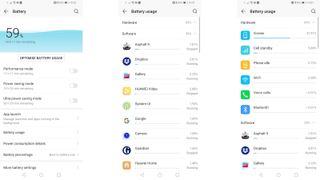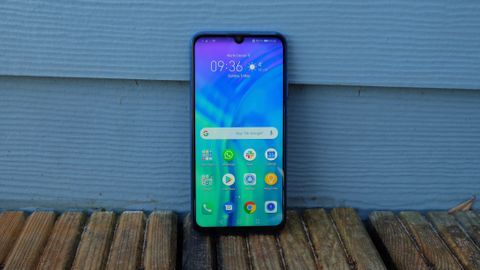Why you can trust TechRadar
Battery life
- 3,400mAh battery
- No fast or wireless charging
It’s a bit of a running theme here, but Honor has stuck with the same battery size as the Honor 10 Lite. This means the Honor 20 Lite also gets a 3,400mAh battery.
Combined with an identical chipset and display, it should come as no surprise to learn that the battery life of the Honor 20 Lite is more or less the same.
In our standard 90-minute looping video test with the screen brightness set to full, the Honor 20 Lite lost 17% of its charge. That’s very similar to the respectable (but far from outstanding) score achieved by its predecessor. Perhaps more importantly here, it’s a score that tops its competitor the Moto G7 Plus on 22%.

Generally, this is a solid all-day phone that will get you through to bed time with plenty of power to spare if you’re a moderate user. On lighter days, it wasn’t unusual for us to be left with 40 to 50% left in the tank, which opened up the tantalizing possibility of two-day usage between charges.
Heavier users, hardcore mobile gamers, and social media hounds can knock a hefty chunk off that remaining capacity. But you shouldn’t need to worry about running out of juice before you get to a wall socket, at any rate.
You don’t get wireless charging here, which you wouldn’t expect at this price point, but you might well hope for some kind of fast charging, which is similarly absent.
Camera
- 24MP + 2MP + 8MP triple camera
- 2MP sensor is purely for depth
- 32MP selfie camera
The big feature for the Honor 20 Lite, and the key differentiating factor from the Honor 10 Lite, is its triple camera array. Honor’s line here is “triple lens, triple the fun”. We wouldn’t go that far, but it is pretty accomplished for a budget snapper.
There aren’t really three cameras here in the traditional sense. One of the three sensors (the 2MP one) is purely for depth detection rather than, say, the telephoto lens included with some other triple-lens cameras. The Samsung Galaxy A7 (2018) adopted a similar approach.
While the Honor 20 Lite will allow you to zoom in by a factor of six, this is a purely digital effect, and the results are extremely noisy as a result. It’s best not to bother, in our experience.
Elsewhere you have a 24MP f/1.8 main sensor and an 8MP wide-angle lens. It’s a similar setup to that of the Huawei P30 Lite.
Switching to the 120-degree wide-angle lens is as easy and quick as pressing a virtual button at the bottom of the viewfinder, but these shots do lack the detail of the more pixel-packed ‘normal’ sensor.

Though it’s toggled off by default, the Honor 20 Lite’s camera does generally benefit from Huawei’s smart AI mode. When activated, this automatically senses the scene from 500-plus scenarios and 22 categories, and makes the appropriate adjustments.
In our experience this mode is well worth leaving on. It often produces shots with a little more pop and balance, without a massive hit to performance.
This is a very good camera for the price, producing detailed, well-lit shots in reasonable lighting. On many occasions it left us flat out impressed, such as when picking out crisp fluffy clouds on a sunny day.
That said, it doesn’t always get the exposure spot-on, and it struggled with dynamic range on a couple of beachside shots during our test period. Things get softer and blurrier in lesser lighting conditions, though colors don’t wash out as much as they can with other budget phone cameras.

We’ve mentioned it already, but there really is a notable difference in the quality and general tone of the pictures from the main camera and the secondary wide-angle one. Indeed, we were left so unimpressed with the zoomed-out snaps that it actively discouraged us from using the option altogether.
The multiple-camera setup enabled some decent portrait shots. However, just grabbing close-ups with the regular camera yielded some pleasing bokeh effects, and with more detail to boot.
We were also quietly impressed with the dedicated night mode, which lengthens the exposure. It doesn’t offer miraculous results, but it does enable you to pull a little more detail out of those murkier shots - as long as everyone keeps still.
Around the front you get a 32MP selfie camera, which really hints at the young audience this phone is aiming for. It’s technically got the same AI smarts and HDR capabilities as the rear array, but it still turns out far inferior shots.
It can’t be ignored that many of these camera options were available on the Honor 10 Lite. Meanwhile the big addition of a third wide-angle camera is arguably one of the weaker elements of the package.
Camera samples










Current page: Battery life and camera
Prev Page Introduction, key features and design Next Page Anything else I should know?